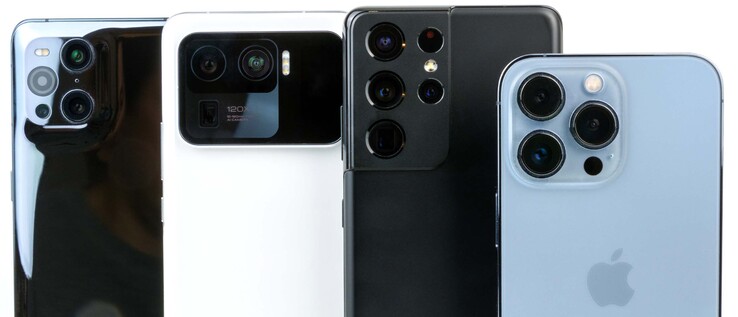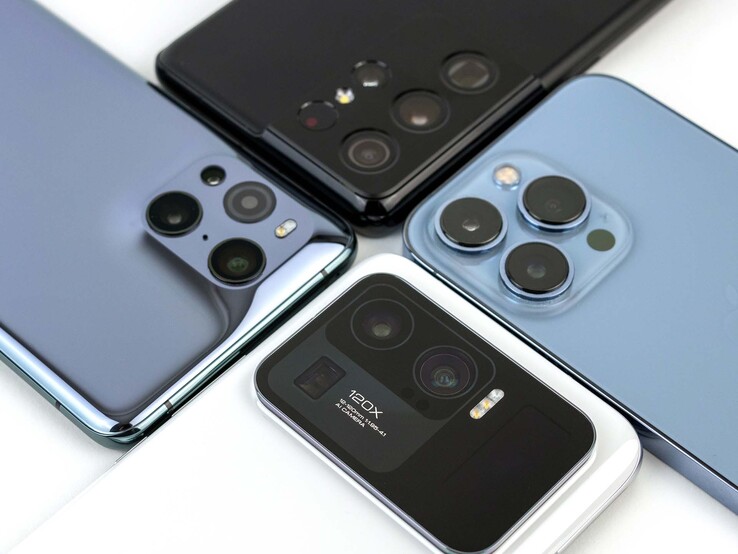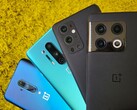Camera comparison: These high-end smartphones take the best photos
We have already tested the current crop of top Android smartphones against each other in the summer. The Samsung Galaxy S21 Ultra and Xiaomi Mi 11 Ultra almost won the test themselves. These two phones are once again in this test and now have to compete against the likes of the Oppo Find X3 Pro and the Apple iPhone 13 Pro.
The prices of these three Android rivals are quite close to each other and none of these smartphones can be bought for less than 1000 Euros (~$1,000). Oppo offers the cheapest entry, but even the iPhone is only a bit more expensive with the smallest storage configuration.
However, the camera equipment couldn't be any more different. The iPhone relies on three 12 MP sensors, which cover almost all needs. In addition to the main camera, Apple provides a 3x optical zoom and an ultra-wide-angle lens, which also allows macro shots at a distance of 2 cm.
The Samsung Galaxy S21 Ultra presents itself with an in-house 108 MP sensor, which is supported by an ultra-wide angle and two optical zoom (3x and 10x) lenses. All in all, the Xiaomi Mi 11 Ultra offers even more megapixels. Although the main sensor is only a 50 MP one, both the ultra-wide-angle, which is also used for macro shots, and the 5x optical zoom lenses are each 48 MP.
The zoom race is won by the Find X3 Pro without parallel. Oppo's smartphone also offers a dedicated zoom lens, but the 2x optical magnification is already the end of the line, and the digital zoom is not really superlative either. Instead, the Find X3 Pro has a microscope camera that enables a 60x magnification. The ultra-wide-angle can fall back on a modern sensor, which is also used in the OnePlus Nord 2.
In our comparison test, all candidates have the latest software (see table) and work with activated AI support and the integrated camera app.
| Apple iPhone 13 Pro | Oppo Find x3 Pro | Samsung Galaxy S21 Ultra | Xiaomi Mi 11 Ultra | |
|---|---|---|---|---|
| Main camera | 12 MP (f/1.5, OIS) | 50 MP (Sony IMX766, f/1.8, 1/1.56", PDAF, OIS) | 108 MP (Samsung HM3, 24 mm, 83°, 0.8 µm, f/1.8, OIS) | 50 MP (Samsung GN2, f/1.95, 24 mm, 1/1.12", 1.4 µm, OIS) |
| Ultra-Wide | 12 MP (f/1.8, 120°) | 50 MP (Sony IMX766, f/2.2, PDAF, 110.3°) | 12 MP (120°, 1.4 µm, f/2.2, DPAF) | 48 MP (128˚, f/2.2, 12 mm, 1/2.0", 0.8 µm) |
| Telephoto | 12 MP (3x opt. magnification, up to 15x digital, f/2.8, OIS) | 13 MP (2x opt. magnification, 5x hybrid, up to 20x digital, f/2.4) | 10 MP (3x opt. zoom, 72 mm, 1.22 µm, f/2.4, OIS, DPAF) + 10 MP (10x opt. zoom, 240 mm, 1.22 µm, f/4.9, OIS, DPAF), up to 100x digital | 48 MP (5x opt. zoom, 10x hybrid, up to 120x digital, f/4.1, 120 mm, 1/2.0", 0.8 µm, OIS) |
| Macro | see ultra-wide angle | - | see ultra-wide angle | |
| Other | LiDAR scanner | 3 MP (microscope, 60x magnification, f/3.0) | - | - |
| RAW mode | ProRAW (12-bit) | Yes (10-bit) | Yes (10-bit) | Yes (10-bit) |
| Front lens | 12 MP (f/2.2) | 32 MP (f/2.4) | 40 MP (f/2.8, AF) | 20 MP (f/2.3) |
| Software version | iOS 15.1 | CPH2173_11_A.24 | RP1A.200720.012.G998BXXS3AUJ7 | MIUI 12.5.10.0 |
| RRP | From 1149 EUR | 1119 EUR | From 1249 EUR | 1200 EUR |
Macro vs. Micro vs. Zoom
As soon as we get into the close-up, the first differences between the rivals become apparent. While the under-performing 2 to 5 MP macro sensors are often installed even in the mid-range, such solutions are not found in the premium smartphones. Rather, they do without them or use the ultra-wide-angle for this task like the iPhone 13 Pro and the Mi 11 Ultra. The other two smartphones use optical zoom instead.
The image quality turns out to be quite different among the contenders. The iPhone convinces with a very balanced and detailed image, but the colors remain a bit pale. We like the Mi 11 Ultra's colors the best, but its picture is largely blurry. Only the center of the picture is reproduced appealingly. The Find X3 Pro oversaturates the colors and lacks some sharpness. The S21 Ultra is the complete opposite, chiseling the entire subject in stone and bleaching the colors.
If the iPhone performed a bit better in terms of color reproduction, it could have been the clear winner in macro photography. However, the Mi 11 Ultra does a better job but exaggerates the bokeh. The Find X3 Pro earns a plus point because it offers a unique alternative with its microscope optics.
Image comparison
Choose a scene and navigate within the first image. One click changes the position on touchscreens. One click on the zoomed-in image opens the original in a new window. The first image shows the scaled photograph of the test device.
Ultra-wide-angle: Slight advantages for Oppo and Apple
More megapixels do not necessarily mean better imaging performance. This hypothesis is supported by Apple with its ultra-wide-angle sensor, which offers by far the lowest resolution with just 12 megapixels, together with the Galaxy S21 Ultra. Xiaomi and Oppo rely on high-resolution sensors that work with pixel binning and thus generate similarly large final results.
The rivals perform close to each other in daylight, but the Galaxy S21 Ultra shows the most natural colors. However, it has to struggle with slight aberrations at the building edges in city scenes. These are even more noticeable in the Find X3 Pro, but Oppo's smartphone manages a more detailed reproduction with more details being especially preserved in the depth.
The Mi 11 Ultra's imaging performance drops in low light, but the Samsung phone also struggles a lot. The iPhone and the Find X3 Pro manage the cleanest photos in this situation although the latter sharpens the image a bit too much in some places.
Image comparison
Choose a scene and navigate within the first image. One click changes the position on touchscreens. One click on the zoomed-in image opens the original in a new window. The first image shows the scaled photograph of the test device.
KircheCity-MotivLow-Light
Zoooooooom: The Galaxy S21 Ultra remains the best magnifier
The Xiaomi Mi 11 Ultra offers the highest possible magnification with a 120x digital zoom. The Galaxy S21 Ultra also has a three digit-100x digital zoom, and it also offers the highest optical magnification with a 10x zoom lens.
In daylight, it is directly noticeable whether optical or digital zoom is used. The iPhone 13 Pro's 2x magnification is not very convincing; the Find X3 Pro manages this best. The Mi 11 Ultra delivers really good results with a 3x zoom, but Apple and Samsung can also deliver good results in this range.
The iPhone 13 Pro and the Find X3 Pro already fall behind the competition a bit in 5x zoom, and the software irons out some structures. The Mi 11 Ultra also reproduces the most details here, but the white balance is too cool.
From 10x zoom onwards, things get muddy with the iPhone 13 Pro while the Oppo smartphone delivers an even more washed-out performance. The results of the other two models remain usable. Samsung, in particular, presents a very natural picture, while the Mi 11 Ultra's is a bit reddish and is sharpened a lot.
Apple stops at 15x magnification and Oppo at 20x. The Galaxy S21 Ultra and the Mi 11 Ultra can offer much more zoom even though the maximum zoom levels are not really useful. The Xiaomi smartphone, in particular, needs a solid base for stabilization. Samsung, on the other hand, offers surprisingly good image stabilization even at long zooms.
Image comparison
Choose a scene and navigate within the first image. One click changes the position on touchscreens. One click on the zoomed-in image opens the original in a new window. The first image shows the scaled photograph of the test device.
2-facher Zoom3-facher Zoom5-facher Zoom10-facher Zoom
Zooming in low light
None of the smartphones deliver a usable result in low ambient light, if a real photo on paper is to be printed. We like the image composition the best in the Apple smartphone, but details are muddy in its pictures as well. The pictures of the Mi 11 Ultra also turn out to be very dark. The Xiaomi phone only manages a pretty good picture at 5x magnification; this is also very dark, but it most closely matches natural conditions.
Image comparison
Choose a scene and navigate within the first image. One click changes the position on touchscreens. One click on the zoomed-in image opens the original in a new window. The first image shows the scaled photograph of the test device.
2-facher Zoom3-facher Zoom5-facher Zoom
Selfie: Top by day, flop by night
The iPhone 13 Pro and the Galaxy S21 Ultra take decent selfies in daylight. Oppo follows close behind, but its pictures are a bit too cool for our taste. The Mi 11 Ultra, on the other hand, exaggerates the blur in the default setting, but this can be disabled in the settings.
The situation is similar in portrait mode. All four rivals reproduce straight edges quite cleanly. All algorithms only reach their limits with wild hair; the Mi 11 Ultra is a bit less accurate here.
Things start to get problematic in low light, and none of the front cameras can really convince. Either the details are blurred and/or the white balance is off. The software of the Galaxy S21 Ultra still works best here, but it renders the subject too cool.
Image comparison
Choose a scene and navigate within the first image. One click changes the position on touchscreens. One click on the zoomed-in image opens the original in a new window. The first image shows the scaled photograph of the test device.
FotomodusPortraitmodusLow-Light
12 to 108 MP and a lot of algorithm
All four competing devices use different main sensors. Nevertheless, all smartphones deliver good results in daylight. The difference is mainly seen in the white balance. While the iPhone 13 Pro selects a slightly warmer white balance, things get cooler with the Find X3 Pro and Mi 11 Ultra. The Galaxy S21 Ultra, on the other hand, casts a slight red tone.
The Android smartphones tend to sharpen the pictures a bit too much via their algorithms, which can sometimes lead to loss of details in the background. Oppo and Xiaomi in particular do a lot of resharpening via the software. For example, the photo at the lake was taken on a very cloudy, slightly hazy day, which can still be guessed well in the S21 Ultra and iPhone 13 Pro. The other two smartphones work harder via software and completely remove the haze from the picture.
In low light, the iPhone 13 Pro demonstrates strong imaging performance in the bunny subject, even when automatic exposure is deactivated. The other three rival phones only show washed-out details, but brighten the picture a bit more. The Mi 11 Ultra, in particular, delivers a pretty weak performance in this test. However, this changes when the night mode is activated or automatically used by the scene detection. The Xiaomi smartphone then generates a very high-contrast picture, which already looks quite artificial. It is similar with the Find X3 Pro and the S21 Ultra, but their pictures are warmer.
On a dark street, the Mi 11 Ultra and the Find X3 Pro can convince with homogeneous illumination. However, the Samsung device goes overboard with the brightening while the iPhone remains a bit too pale.
Image comparison
Choose a scene and navigate within the first image. One click changes the position on touchscreens. One click on the zoomed-in image opens the original in a new window. The first image shows the scaled photograph of the test device.
HaseSeeStrasseLow-LightNachtmodus
Verdict - Preferences Roulette
All four smartphones offer strong camera setups. The quality is even better compared with the upper mid-range or cheaper flagship models. This is not only noticeable due to the more powerful main sensors but also due to the additional lenses. These expand the range of applications enormously, and those preferring ultra-wide-angle sensors will find much better lenses in the high-end range than in inexpensive models this year.
There is no clear winner that dominates all areas. The iPhone 13 Pro shows a very wide range of possibilities, which all rank on a good level. Richer colors would have been more appealing for the macro shots, since they otherwise differ too much from the main lens. Compromises in zooming are needed with Apple's smartphone.
It is a tough fight among the high-end smartphone cameras. We cannot identify a clear winner; buyers should be better aware of the intended use and personal preferences.
Oppo succeeds with the Find X3 Pro. It manages a strong setup, whose shortcomings are mainly found in long zooms. There is no macro solution, but it is the only smartphone with a microscope camera.
Samsung offers a strong overall package with the Galaxy S21 Ultra but no macro mode. Close-ups can also be taken via the zoom, but they do not reach the quality of competing devices. On the other hand, Samsung's smartphone flexes its muscles when zooming and benefits especially from its very good image stabilization, which enables shake-free pictures even at a magnification of 50x or more.
The Mi 11 Ultra also offers a strong overall package from macro to 120x magnification. However, Xiaomi goes overboard a bit with the bokeh in macro mode or rather, the focus range is quite small. A solid surface is necessary to hold the camera steady enough at long zoom levels.
The choice of cameras depends on the user's preferences, but none of the smartphones achieve bad results.
Prices and availability
There are bottlenecks in the smartphone availability, especially for the Mi 11 Ultra. It is not available in the manufacturer's store or on Amazon at the time of the test, but it can be imported with an EU ROM via TradingShenzhen, among others and is available for less than 800 Euros (~$800).
Not all storage variants of the Galaxy S21 Ultra are available immediately, and delivery delays can also occur at Apple depending on the color choice and storage configuration. The Find X3 Pro is quite stable in terms of price, but it also has availability issues.
| Xiaomi Mi 11 Ultra | Samsung Galaxy S21 Ultra | Oppo Find X3 Pro | Apple iPhone 13 Pro |
|---|---|---|---|
| Xiaomi Shop | Samsung Shop | Sparhandy | Apple Store |
| Amazon | Cyberport | Amazon | notebooksbilliger.de |
| TradingShenzhen | notebooksbilliger.de | MediaMarkt | OTTO |









